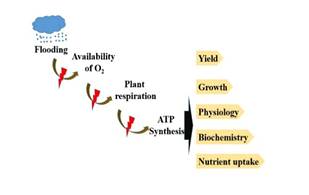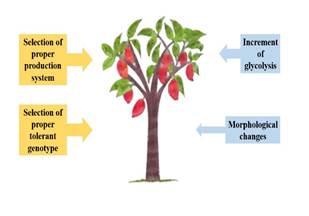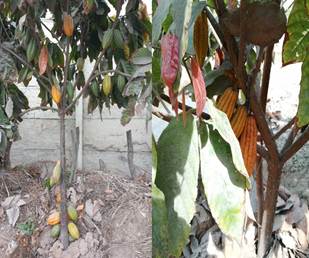Introduction
The cocoa production is the main livelihood of 5-6 million of smallholders distributed in developing countries as Ivory Coast, Ghana, Indonesia, Nigeria, Cameroon, Brazil, Ecuador and Peru1,2. Within those countries, the cocoa production is located in forestland where it has an important ecological role maintaining the biodiversity of insects and plants, and increasing the carbon sequestration3-6. Likewise, cocoa production has key social role since it generates employment. For example, in Peru, around of 190 thousand families and 450 thousand people both depend on cocoa crop7 (Figure 1).
It is indubitable that crop productivity is associated to climatic conditions, hence any modification in this can disturb the development and growth of the cocoa trees. Therefore, there are two phenomena associated to climate change: drought and flooding. Although, the damage caused by water deficit is more intense than water excessive8, however, the waterlogging can disrupt the good performance of photosynthesis9 and it decreases the yield of crops10. For that reason, it can be considered a threat to the food security11.
In the last years, the global climate has come changing dramatically, increasing among other parameters,
the presence of heavy rain in short periods12 putting the production of certain crops at risk, especially those grown on forestland or near to river bank as cocoa (Theobroma cacao L.). This is due to the fact that overabundance of water on soil decreases dramatically the presence of available O2 (anoxic) to roots provoking physiological, morphological and biochemical changes of the cocoa plant, causing decreased yields13,14 (Figure 2).

Figure 2 Effect of flooding in plant development. Prolonged periods of rain may provoke flooding that, at the same time, decreases the availability of O2 to plants. In these circumstances the respiration is disrupted, and consequently the ATP synthesis. All those changes can negatively affect the physiology, nutrient uptake, growth and yield of crops, particularly cocoa
In order to face this abiotic problem, we need to know the impact of flooding on different aspects that determine the adequate growth and yield in cocoa trees. In spite of the waterlogging stress can potentially increase its negative impact on cocoa plantations, information on the issue is scarce. Additionally, the material relates to this stress is dispersed. In this context, this review aims to group and classify all information of the impact of flooding on the cocoa plant.
Development
Effect on physiology of cocoa. Photosynthesis is one of the most important physiological processes in plants15 being responsible for synthetizing carbohydrates, that will be used to maintain the growth and development of crops16. To carry out this vital process the plants count on a photosynthetic apparatus that transforms the sunlight in energy.
That process is highly dependent on the entry of CO217. Therefore, whatever that disrupt the entry of CO2 into plants can impair the photosynthates production. This relationship also denotes the high impact of abiotic factors, such as flood, on photosynthesis.
When the soil is totally covered by water, cocoa physiology in terms of photosynthesis and stomatal conductance9,18 are affected. In fact, the former can be reduced by 60-83 %13,19, meanwhile, the latter can reduce by 81 %13. Furthermore, the transpiration is reduced by almost 60 %. The reduction in both photosynthesis rate and stomatal conductance could be associated to stomatal closure20 that, at the same time, could be correlated to hormones such as ethylene21.
On the other hand, the photosynthetic apparatus is formed by Photosystems (FS) (I and II) whose functions are to catalyse the transfer the electrons from plastocyanin to ferrodoxin (FS I) and to oxidize water (FS II)22,23. One of the methods to measure impact of abiotic stress on PS II is quantifying the fluorescence24. Interestedly, although some researchers as Bertolde et al.13 documented that Fv/Fm can be negatively affected by excess water in the soil, other such as Costa et al.25 showed that photosynthetic efficiency (Fv/Fm) was almost constant in plant under flood stress, but the same plants rapidly modified the total performance index (PItot), suggesting the latter may be better parameter to evaluate the impact of waterlogging on plant vitality26. According to Živčák et al.27 and Swoczyna et al.28, PItot is related to quantum efficiency to reduce the PSI with photons from FSII. Regarding PSII fluorescence, da Silva Branco et al.29 informed that flooding stress decreases qp as tolerant cultivar as resistant cultivar. Nevertheless, cocoa plants under anoxic conditions can slightly raise the water use efficiency (WUE)30.
Effect on biochemistry of cocoa. The activity of different protective enzymes allow plant to survive adverse conditions. The enzymatic response depends on the genotype as evidenced by Bertolde et al.13 in an experiment in which they observed that tolerant and susceptible genotypes to flooding showed differentiated enzymatic activity (Peroxidase and Polyphenol oxidases) compared to Control. The plant response also depends on time of exposure.
Furthermore, the content of starch and soluble sugars, in general, was reduced in the roots of plants subjected to waterlogging13, pointing out the high susceptibility of this organ to excessive water. In addition, proline might be an indicator of stress due to excessive water, but only for short term response, although it depends on cultivar studied8.
In this review, we found low information about the relation between anoxic (waterlogging) and respiration. However, the data found demonstrate that in flood-tolerant genotypes of cacao (TSA-792), the activity of alcohol dehydrogenase (EC 1.1.1.1), pyruvate carboxylase (EC 6.4.1.1) and lactate dehydrogenase increases, suggesting that an increment of glycolysis may be proper strategy used by tolerant genotypes13. This strategy is mentioned by other author s such as31 who also reported that glycolysis helps plants to produce rapidly ATP.
Effect on nutrient uptake. The plant nutrients are many important because ones prompt the growth and development of plants, Therefore, a deficiency in their content can affect the yield of plant as cocoa. The levels of nutrient in plants are severely affected by the excessive water on soil. Macronutrient such as N, P, K, Ca and Mg were negatively affected by overabundance of water on soil13,32. In the case of micronutrients (Fe, Zn, Cu and Mn), the cocoa plants (both tolerant and susceptible to waterlogging) under flood stress had low absorption of these elements.
Effect on growth and morphology of cocoa. Inhibition of plant growth caused by waterlogging is reported in many crops, such as tomato33 and oilseed rape34. In the case of cocoa, the suppression of vegetative growth by flood stress is pointed out by de Almeida & Valle14 who stated that these phenomena limit the initial growth of cocoa seedlings diminishing the leave area and provoking the falling of leaves.
Likewise, in an experiment with a four months old seedling subjected to waterlogging by one month, the researchers noticed some symptoms of hypoxic such as chlorosis in mature leaves, decreased leave formation, and reduced of root carbohydrates13,32.
The reduction of growth is probably related to reduction of dry matter as informed by Prawoto et al.35, who determined that soil water content 25 % above of field capacity (FC) decreased the dry matter by 13 %, likewise, when the soil water content was 75 % above FC the reduction of dry matter was 34 %. These results are according to other ones informed by de Almeida & Valle14 and Rehem et al.32. Other traits studied in cocoa cultivars were the relative growth rate (RGR) of leaves and roots which decreased when the plants grew under excessive water18,32. However, the specific leaf area (SLA) increased in the same experiment32.
A probably mechanism to overcome the hypoxic caused by waterlogging is the increment of lenticel on the trunk of cocoa tress as reported by de Almeida et al.19, Rehem et al.32 and Bertolde et al.36. In this sense, other researchers found overabundance of soil water stimulated the production of hypertrophied lenticels and adventitious roots in Quercus robur and Quercus petraea37. Other morphological strategy is the formation of adventitious roots36. Furthermore, adaptations of cocoa plants under waterlogging are the reduction of xylem, phloem and mesophyll length38.
Effect on production of cocoa. In spite of there is a lot of information about the effect of waterlogging in different crops, in the case of cocoa this type of information is still scarce. According to de Almeida & Valle14 the anoxia can reduce the productivity until 60 %.
Strategic adaptation to waterlogging. In order to deal with excessive water on soil, we need to start choosing a vegetative material suitable which be tolerant to flood stress (for instance TSA-792, CP-49)32,39. We must also select a proper production system as agroforestry system (AF). In fact, in an AF the number of survived cocoa plants was higher than cocoa trees unshaded, both growing under flooding40. Other strategies recorded were the increment of the glycolysis and morphological modifications (e. g. increase of lenticels)36,38 (Figure 3).

Figure 3 Strategies to cope with waterlogging for cocoa plantations. To limit the impact of flood on cocoa trees first we have to choose proper production system (for example, agroforestry system). Second, we need to use tolerant cultivar. Internal and external processes such as glycolysis and morphological changes can help cocoa tress to overcome flooding stress
Future perspectives
Finally, after searching for information related to the effect of waterlogging on cocoa plants, it has been shown that excess water in the soil (anoxic) can negatively affect the physiology (e. g. reducing net assimilation and stomatal opening), enzymatic activity of peroxidases and polyphenol oxidases, absorption of nutrients (macro and micro nutrients) and the growth of cocoa plants. However, this specie has certain mechanisms to counteract the damage of the lack of oxygen in the root zone, such as the increase of glycolysis. As well, this specie forms lenticels when it is under anoxia. Different agronomic practices can be important to counteract the effect of flood; for example, we have to choose appropriate system of production (in this case agroforestry) and to cultivate flooding tolerant genetic material. In spite of information exists about this issue, it is necessary more research in order to understand better what mechanisms cocoa plants have to survive, or overcome the anoxic condition.












 uBio
uBio 



